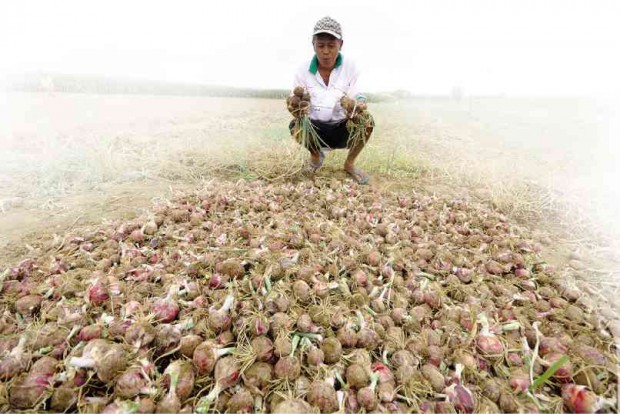Rains remove spice from onion-growing

A FARMER harvesting onions in the village of Baluyot in Bautista town, Pangasinan province in March 2015 many months before the rains all but wiped out their produce. WILLIE LOMIBAO / INQUIRER NORTHERN LUZON
BAYAMBANG, Pangasinan—Onion growers may be unable to recover this planting season after about 70 percent of their farms in six villages here were destroyed by three days of continuous rain in December, Mayor Ricardo Camacho said.
“The rain was something we did not expect in December. So our onion farmers were [devastated],” he said.
Typhoon “Nona” (international name: Melor) dumped rain in Pangasinan from Dec. 15 to 18 as it crossed islands in the Visayas and Luzon before dissipating in the West Philippine Sea.
“Even our corn plants died when the farms were flooded. But what hurt us most was when we lost our onions. This was the first time that this happened. Many farmers planted onions this season compared to the previous seasons,” Camacho said.
Still under water
Bayambang is the Ilocos region’s top onion producer with at least 650 hectares of land planted to the crop in the southern villages of Manambong Sur, Manambong Norte, Manambong Parte, San Gabriel II, Paragos and Iton.
Camacho said most of the farms are still under water, making it impossible for farmers to replant onions.
In March last year, farm gate prices of red onions here dropped, sending hundreds of farmers worrying about how to recoup their farm expenses. A kilogram of red onions sold for P10 to P13, the lowest price that onion farmers experienced in the last 15 years.
Camacho said they expect prices of onions to go up this year after the destruction of farms here and in nearby Nueva Ecija province. He said an onion farmer spends P150,000 to P175,000 to produce 15 metric tons of onions from every hectare.
Nestor Batalla, assistant provincial agriculturist, said the rain dumped by Nona also destroyed onion and corn farms in the neighboring towns of Bautista and Alcala.
Rodrigo Tagulao, Bautista town agriculturist, said at least 50 ha of onion farms in four villages and some 350 ha of corn farms in 18 villages were destroyed.
“Their roots rotted when it rained for three days,” said Tagulao.
Edgardo Tugas, Alcala town agriculturist, said about 30 ha of onion farms and 1,000 ha of corn farms were destroyed. Gabriel Cardinoza, Inquirer Northern Luzon














